Choosing the Best Adventure Bike
On the surface buying an adventure bike seems pretty simple, you buy a bike, bang on some luggage, load it with gear and head off on an adventure, right? Well, most seasoned adventure riders will agree that there is a lot more to it than that. There are a number of important factors to consider when choosing an adventure bike that is suitable for you, and your style of riding.
So, What is the Best Adventure Bike?
This is a question that has been debated to death. It comes up on biking forums and social media repeatedly and in most cases, never really arrives at a definitive answer that everyone agrees on. This is usually due to people's differing views on what adventure riding is to them, and how this influences practical bike selection for the type of adventure riding they do.
Let's take for example a recent encounter I had with a BMW GS 1200 owner. I bumped into him at a fuel stop, we got chatting and he told me that he often heads out for two day weekend adventure rides made up of mostly tarmac and gravel roads, and enjoys the comfort of staying at luxury accommodation. He was very forthcoming in sharing all the great features and benefits of his beloved BMW GS 1200, and was quick to tell me that this was, indisputably, unquestionably, the best adventure bike money can buy!
There was no point debating his claims because to be fair, he has selected a great bike for his style of adventure riding. A great bike for him yes, but utterly impractical for someone like me. My spin on adventure riding is multi-day camping rides through remote places full of challenges, river crossings, hill climbs and similar gnarly things that make the GS1200 far far too big for me to consider.
The point from these two scenarios is that the term “adventure riding” means totally different things from one rider to the next. Because most rider’s preferences can vary so greatly it naturally puts completely different demands on a motorbike. So, with this in mind, it is simply impossible for there to be just one bike to satisfy the question, what is the best adventure bike?
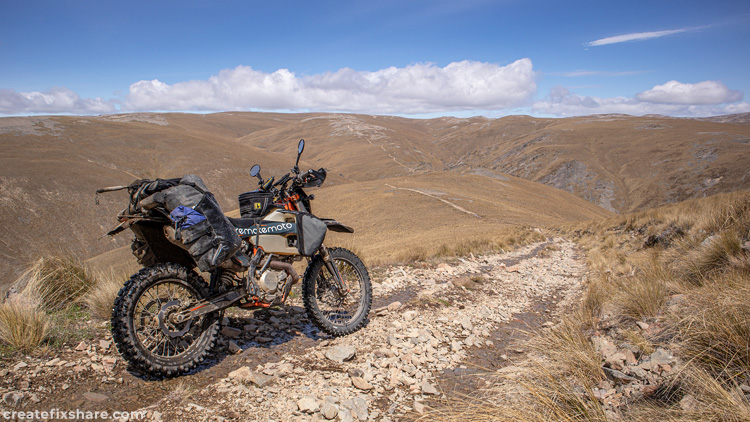
With the above in mind, this article runs through the main attributes of a motorbike which can be used as a checklist against potential adventure bike candidates.
Adventure Bike Engine Capacity
There is a wide and varied range of engine capacities from adventure riders all over the world. I remember on one of my trips as I was heading up a New Zealand High Country track, I crossed paths with a chap riding a CT 110. His bike was fully customized for adventure riding, and was loaded up to the hill with what looked like enough gear for a worldwide tour three times over! Although a number of people use smaller capacity engines (250 cc or less) personally I wouldn't recommend it. I spent the best part of two years exploring the South Island of New Zealand on a DRZ250 and although I had a fantastic time on a string of brilliant trips, the downsides of a small capacity engine had me upgrade to a larger capacity bike.
Disadvantages of small capacity engines
- often struggle to maintain 100 km/h + on the open road or gravel roads
- the majority of small capacity engine bikes have shallow gearbox clusters meaning changing sprocket gearing will either suit off-road, or on road, but not both
- hills and head winds knock your speed back
- working a small engine hard chews through the gas. When fully loaded, my DRZ250 would work hard and in some cases use more gas than a DR650
- keeping up with other riders on bigger bikes can be a continual battle
- overtaking on the road can potentially be dangerous without the power to quickly overtake and get back on your side of the road
- steep hill climbs and technical off-road terrain can mean lots of clutch fanning if you're gearing is more road oriented
- Lack of low down torque for chugging through rivers or other slow speed terrain
Excluding some of the more powerful modern adventure bikes such as the WR250R and the KTM250 EXC-F, personally I would say a minimum engine capacity for adequate power in all areas is 400 cc. Naturally a larger engine capacity will give you increasingly more power and a smoother ride, but every additional cc contributes to more bike weight (especially when you get into twin cylinder engines), which of course leads onto…
Adventure Bike Weight
The weight of an adventure bike is mostly dictated by the engine capacity. Engines are the heaviest component on a motorbike, so the bigger cc it is, normally the more it will weigh. The major considerations for bike weight should be based around the size/strength of the rider with the main focuses being:
- can you ride it for extended periods without getting fatigued?
- can you manhandle it through technical sections?
- can you pick it up when it goes over?
- can you recover it from a precarious situation e.g. mud holes, down a bank etc
Ideally you want as much power as possible without having too much weight for your size, strength and the bike's intended purpose.
Bike weight becomes more of a factor as the technical aspect of the terrain you intend tackling increases. It can be considered critical if you do a lot of technical riding or remote solo riding. Having a bike that is too heavy for you can remove a lot of fun from riding if it is continually playing on your mind.
Every now and then I ride with a few big lads on their big bikes. Given their size, they can handle their big bikes, but it certainly gives them a workout in the rough stuff. I remember on one of the New Zealand DB1K events where I teamed up with a guy name Shrek who was riding a BMW GS 1150. There were many sections made up of kilometers of loose steep rocky mountain terrain. While many riders chose to take an easier route, he powered through and rode the sections with basically no problems (only a few pushes in a couple of steeper parts from some friendly riders). However, I have never seen a man huff, puff, and sweat so much!
A big bike can be just as capable as a smaller bike in “most” off-road conditions, but it normally means a lot of extra effort, and you often feel beat up at the end of the day.
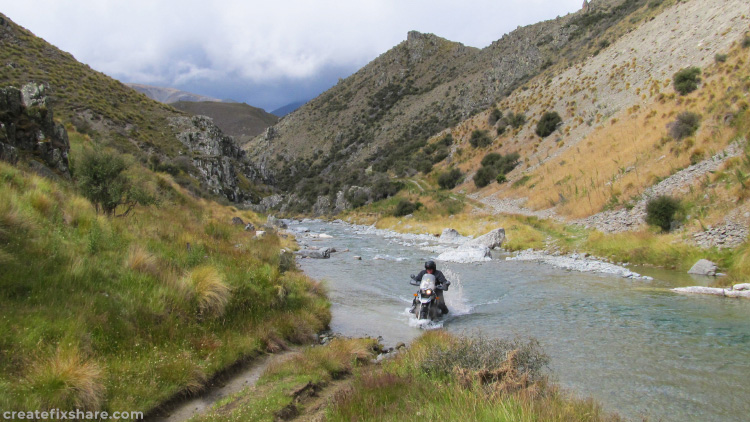
A rule of thumb that most riders will agree with is, if you frequent the rough stuff, the lighter the better.
Lightweight, Midweight and Heavyweight Adventure Bikes
Adventure bikes are typically put into three main groups based on weight (fueled without gear):
Lightweight adventure bike – typically weighs in at sub 140 kg
Midweight adventure bike – typically weighs in between 140 kg to 180 kg
Big adventure bike – typically weighs in at around 180 kg and upward
Below are three examples that fall into the three main adventure bike weights.
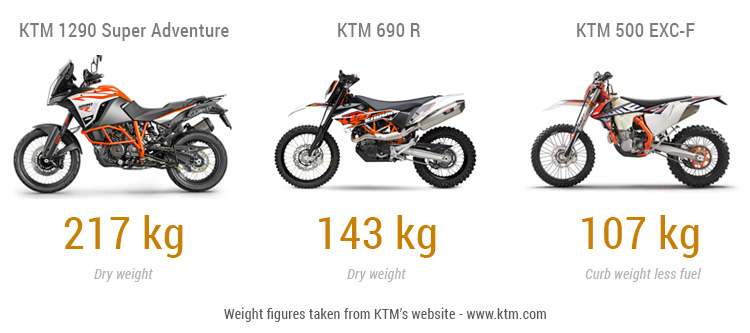
Being reliant on a second person to help you lift up a heavy bike that is fully laden may not really be an issue if most of your riding is with a riding buddy, or a riding group. However, it can certainly play on your mind while riding the remote rough stuff solo. Because I do a lot of solo riding, I've chosen a light bike that I can manhandle in the rough stuff with ease and pickup without issue. Rule of thumb, if you ride the rough stuff then weight should be considered, if you ride the rough stuff solo, then weight should definitely be considered
Adventure Bike Seat Height
Seat height plays a pretty important role when tackling off-road sections. If your seat height is too high it can make it extremely difficult to plant a foot on the ground and take the weight of the bike when you need to. A crucial time to do this would be when crossing deep rivers where dropping it will inevitably lead to a drowned bike. Even more crucial, is when someone is waiting on the other side of the river with a camera!
Personally I like to have the balls of both feet touch the ground by minimum. The problem is, if you’re medium to short in height, very few bikes offer this from factory. Many bikes have fairly high seat heights, and when it comes to performance off-road bikes (suitable for adventure riding) normally they have an even higher seat height. It is common for seat heights to vary considerably. The example below shows how the Yamaha XT250 is significantly lower than the Husqvarna FE 510.
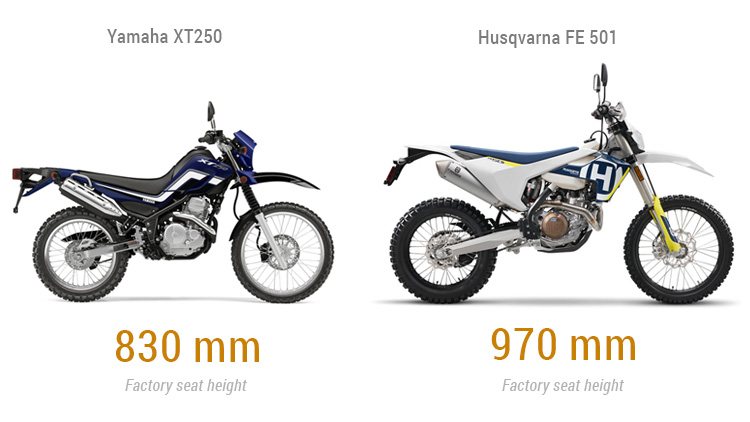
Dealing with a seat height that is too tall is common, and has a few solutions...
Aftermarket seats
There are a number of manufacturers that produce aftermarket seats. Not only do they lower the factor seat height, many are more comfortable for long distance riding than stock seats. A great number of bike makes and models are catered for. The price will vary depending on whether you are just getting a basic re-foam kit, or you get an entire seat that includes the seat pan.
Sculpted/modified factory seats
Modifying factory seats is a very common way to reduce factory seat height and improve comfort. Most auto upholsterers will be able to perform this simple task for a fraction of what aftermarket seats cost, and they can be customized exactly to your preferred seating position and height
Lowering the suspension on the bike
Lowering the suspension on an adventure bike is pretty commonplace. Depending on your budget, or the performance factor, there are two main options:
Option 1: if you are only looking to lower your bike about an inch, then this can be easily done with lowering links in the rear, and moving the forks up in the triple clamps an equal amount. It is important to note you are technically changing the architecture of the rear swingarm and altering the way it performs. Normally only lowering around 1 inch does not detrimentally affect the suspension performance. For many bike models, this can be a low-cost way of lowering a bike for under $200, and just a couple of hours in your workshop.
Option 2: if you are looking for the best performance option, a suspension specialists can lower and tune the suspension factoring in your height, your weight, average bike load and riding style. The price for this is going to vary from specialist to specialist, and if you upgrade some or all of your suspension components. A ballpark figure for a middle of the range tuning is around the $1500-$3000. If you go down this path you’ll agree is it money well spent as it is far superior to the lowering link path.
If the seat height of a potential bike is far too high for you (eg 4 inches or more) it may be a case of that bike not being suitable. There is a limit to the amount some bikes can be lowered before the suspension is affected to the point it becomes a pig. It may pay to check adventure bike forums to see what other owners of the same bike have done, and what is the most effective method of lowering.
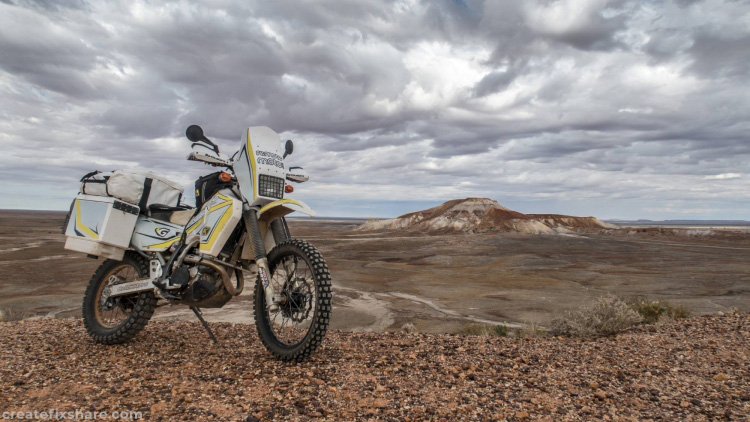
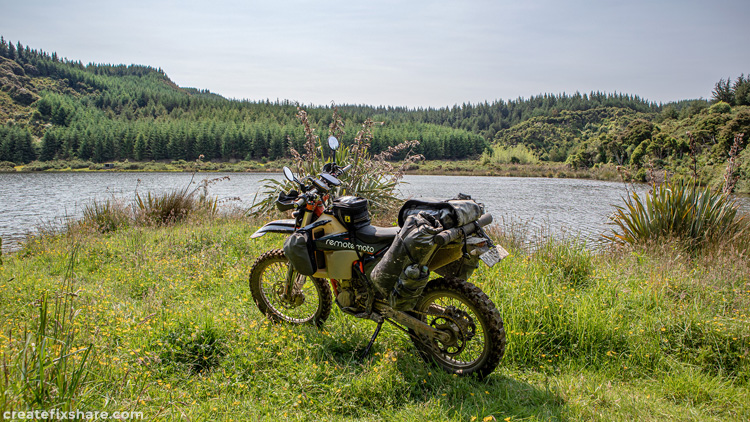
Adventure Bike Riding Position and General Comfort
The riding position will vary from bike to bike. You can sit on one bike and it will feel comfortable then sit on another and it just doesn't feel right. If a particular bike ticks all the boxes for you but the riding position just doesn't feel quite right, this shouldn't be a showstopper as riding position is customizable. All three main components of the riding position (handlebars, seat and footpegs) can all be altered with either factor parts (or adjustment), aftermarket parts or modification.
Handlebar positioning
A common alteration to riding position is raising the handlebars giving a more upright and relaxed riding position. In most cases bikes can be made comfortable to a rider with altering this alone. On some modern bikes the triple clamps allow you to adjust the rise of the handlebars, however most bikes require the addition of either bar raises or aftermarket handlebars with an extended bend. Either is fine but I prefer the latter as there are some really nice looking and durable 1 1/8 (oversized) aftermarket bars available.
Seat positioning
This is also mentioned the in "Seat Height" section above but naturally plays part in your seating position on the bike also. Aftermarket seats or customizing factory seats is a very common option to get the seat at the right height. With the right planning you can kill two birds with one stone by getting the right height for you plus making the riding position more comfortable.
Footpeg positioning
Modifying the footpeg position is not a common alteration (for most bikes) because you can normally get a very comfortable riding position by altering just the handlebars and/or seat. If however you feel the footpegs are definitely too high/low/forward/backwards to your liking this can certainly be rectified. For some bikes there is an easy option, for others there is more work involved.
Bolt-on options - Some bikes have aftermarket available options in the form of complete bolt-on footpeg kits or footpeg relocation plates allowing you to use your original footpegs.
Modification For bikes that don't have this option available a little bit of fabrication will be needed, this normally involves relocating the footpegs by means of fabricating new mounting plates.
Fuel Injected or Naturally Aspirated?
One topic (debate) that comes up quite frequently amongst riders is electronic fuel injection, but moreover, the reliability of it. Many people instantly dismiss fuel injection because it introduces a new technical element into what is primarily a simple machine. The fact electronic fuel injection systems normally require specialized testing equipment to diagnose problems can be considered a big negative opposed to a naturally aspirated carburetor that can normally be successfully worked on and/or have parts replaced with standard tools out on the trail. This can often avoid the need to transport the bike to a workshop in the case of a carburetor breakdown, but of course this is not always the case.
Avoiding EFI is becoming a hard thing now that more and more bikes on the market are sporting electronic fuel injection, but to be fair, technology has advanced and electronic fuel injection has proven itself to be a predominantly reliable and dependable component. If you talk to someone that has done numerous years of travel on fuel injected bikes they'll soon tell you to stop fretting, stop overanalyzing, and just ride! The fact more and more bikes are fitted with electronic fuel injection should be proof in itself that it should be considered a dependable component.
Air Cooled or Water Cooled?
Air cooled engines like on the DR650 for example removes a multifaceted maintenance component of an entire cooling system consisting of a water pump, water hoses and radiators. There is no denying the lack of these extra components removes the failure possibility with any of them and can be considered a positive aspect, but then again a water cooled system provides a more consistent and regulated running temperature and is a lot friendlier on your motor. The most vulnerable facet of water cooled bikes is damaging the water cooled system in a crash, somewhere remote. An air cooled motor isn't prone to a radiator being pierced by a branch or large rock, a radiator hose bursting or the water pump failing, but to address this a comprehensive toolkit can adequately cater to most water cooled engine repairs on the trail.
Excluding some of the tried and true air cooled models like the DR650 that are still being produced, the majority of bikes nowadays are water cooled. In my opinion there are many more important areas to consider such as weight, seat height, engine capacity etc when choosing your adventure bike. Being air cooled or water cooled shouldn’t really be considered a showstopper. If you end up purchasing an air cooled bike, it has the benefit of ruling out water cooling system maintenance. If you end up purchasing a water cooled bike, it simply means your maintenance routine should include ensuring the cooling system is well maintained, and your toolkit contains the items needed to perform repairs out on the trails.
Crashability
Many modern bikes have a lot of fancy plastics and shrouds that don't do well in an off, but that's not really the true definition of crashability. Although it is a disadvantage due to the fact some of those plastics cost an arm and a leg, what we are really looking at is if you can crash the bike, pick it up, and continue riding. Most true adventure bikes do handle well in an off, but a major factor comes down to the way you setup your bike for adventure riding.
Depending on the bike you choose, and the bike’s potential vulnerabilities (eg exposed water pump housing, weak factory handlebars) bike protection and upgrades should be fitted to ensure your bike is as crash-proof as possible. That is an extensive topic all on its own but in brief we are talking about bashplates, case protectors, crash bars, rad guards, barkbusters, oversized bars, etc.
Reliability and Longevity
The more remote places you ride, the more important reliability becomes. If you predominantly ride tarmac and gravel roads all within mobile phone range, then reliability is not as big of a factor as someone embarking on multi-week ride across Russia. Most well-known make and model motorbikes are very reliable when purchased new. Some more than others, but most major design faults have been identified, removed and refined from bikes ageing past their debut period.
This should be given some serious thought whether you are purchasing a second-hand bike or a new bike. Ideally you want to do your homework and find out if there are any potential known issues with the particular make/model/year you are considering buying. As an example, the DR650 had an issue with third gear disintegrating on models pre 2006, the DRZ400 had a cam chain tensioner issue pre 2003. Motorbike forums and Google will be your best friend to find out any potential problems.
Keep in mind the above certainly doesn't include the ultra cheap Chinese or other cheap unknown brand motorbikes. The reliability of these bikes generally isn't great. Rather than enjoying your ride, you may end up having to organize a vehicle to haul a broken down bike back home.
Adventure Bike Part Availability
Part availability is really only a major factor when you are doing lengthy adventure riding in remote and/or overseas countries that may not have good stockholding of parts. As a local example, here in New Zealand you would more than likely be able to track down pretty much any part for a DRZ400 and have it overnight couriered to you. However, for a Husqvarna TE630 it could be a different story and it may have to be ordered in from overseas.
This is more of a consideration for those embarking on overseas trips where making borderlines by certain dates is more crucial compared to packing up your bike and heading off for a few days only a few hundred kilometers from home. Rule of thumb though, the more common the bike (eg DR650), the easier it will be to source parts.
Adventure Bike Maintenance Routines
Generally speaking, the more high performance the bike is the more frequent the maintenance routines will be. For example, riders that use a KTM500 for adventure riding will normally perform oil changes at around the 1,500 km to 2,000 km mark. This exceeds the factory recommendation of 15 hours due to the factory recommendations being based on hard competition riding that is rarely mimicked by your typical adventure rider. Riders that use a DR650 for adventure riding will normally perform oil changes at the factory recommendation of 5,500 km.
It all comes down to the performance you want out of your bike and understanding that higher performance requires higher maintenance. If you can structure your riding around servicing the bike more regularly and you want to take advantage of lightweight enduro bikes that offer fantastic suspension and adrenalin pumping power, then that's a feasible option, and certainly a fun one!
Working out the average mileage from the style of riding you intend doing will pretty much dictate which bike will or will not fit your preferred maintenance routine criteria. A quick Google search will soon tell you the maintenance routines for potential bike candidates.
Aftermarket Parts and Upgrades
Most bikes marketed or suitable for adventure riding have a number of companies producing aftermarket equipment to deck-out your machine for adventure riding such as long range tanks, pannier racks, screens etc. Bikes that are new to the market or those not specifically intended for adventure riding can prove to be a problem as oftentimes options are limited, or in some cases non-existent.
A DRZ250 was the first bike I setup for adventure riding, there was basically nothing available for this bike as upgrades to suit adventure riding so I had to customize a large tank, screen, pannier racks, panniers, etc. This not only cost me a fortune, it took weeks and weeks of work to complete. Bikes that have off-the-shelf options available will normally be a lot more cost-effective and time friendly to setup.
It would pay to look into what you need your bike to do and if the available gear will tick all the boxes. If a particular bike doesn’t have the aftermarket options available and it is not feasible to fabricate it, it may have to be struck from the list.
New or Second Hand?
In a perfect world where your bank account has endless amounts of sweet sweet cash, the obvious answer is buying new. Buying new ensures you are getting a reliable machine that theoretically should run without issues for a good few years to come, plus the benefits of a factory warranty. If finances don’t allow or you opt to go second hand, check the bike over thoroughly to detect and eliminate bikes that have a shady maintenance history, been neglected, abused or damaged. People who look after their bikes will normally always keep the receipts for maintenance and repairs so ideally ask to see these. The more remote your planned adventure rides are going to be the more reliable you want the bike to be.
If you do go down the second hand path, this may be helpful: Checklist for purchasing a second hand adventure bike.
Final Summary: The Closest One to the Best One is the Right One
Although there are no strict rules and any bike can be used for adventure riding, certain bikes will fit a rider’s riding style, terrain demands and route distances much better than others. It can be impossible to find a bike to tick every box, but there are many bikes that will tick most boxes. The more suitable the bike, the more enjoyable adventure riding will be, and really that’s what it’s all about! Happy riding :)